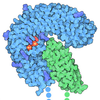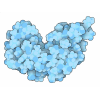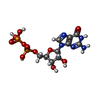[English] 日本語
 Yorodumi
Yorodumi- PDB-9cho: Autoinhibited full-length LRRK2(I2020T) on microtubules with MLi-2 -
+ Open data
Open data
- Basic information
Basic information
| Entry | Database: PDB / ID: 9cho | |||||||||
|---|---|---|---|---|---|---|---|---|---|---|
| Title | Autoinhibited full-length LRRK2(I2020T) on microtubules with MLi-2 | |||||||||
 Components Components | Leucine-rich repeat serine/threonine-protein kinase 2 | |||||||||
 Keywords Keywords | PROTEIN BINDING / Kinase / GTPase | |||||||||
| Function / homology |  Function and homology information Function and homology informationcaveola neck / negative regulation of protein processing involved in protein targeting to mitochondrion / beta-catenin destruction complex binding / regulation of branching morphogenesis of a nerve / regulation of kidney size / Wnt signalosome assembly / regulation of cell projection organization / tangential migration from the subventricular zone to the olfactory bulb / GTP-dependent protein kinase activity / regulation of SNARE complex assembly ...caveola neck / negative regulation of protein processing involved in protein targeting to mitochondrion / beta-catenin destruction complex binding / regulation of branching morphogenesis of a nerve / regulation of kidney size / Wnt signalosome assembly / regulation of cell projection organization / tangential migration from the subventricular zone to the olfactory bulb / GTP-dependent protein kinase activity / regulation of SNARE complex assembly / regulation of neuroblast proliferation / regulation of ER to Golgi vesicle-mediated transport / protein localization to endoplasmic reticulum exit site / peroxidase inhibitor activity / negative regulation of late endosome to lysosome transport / regulation of mitochondrial depolarization / negative regulation of protein targeting to mitochondrion / positive regulation of dopamine receptor signaling pathway / amphisome / regulation of synaptic vesicle transport / regulation of CAMKK-AMPK signaling cascade / regulation of lysosomal lumen pH / co-receptor binding / negative regulation of GTPase activity / regulation of neuron maturation / regulation of dopamine receptor signaling pathway / positive regulation of microglial cell activation / regulation of retrograde transport, endosome to Golgi / positive regulation of synaptic vesicle endocytosis / cytoplasmic side of mitochondrial outer membrane / negative regulation of excitatory postsynaptic potential / negative regulation of autophagosome assembly / JUN kinase kinase kinase activity / olfactory bulb development / neuron projection arborization / striatum development / multivesicular body, internal vesicle / regulation of dendritic spine morphogenesis / mitochondrion localization / protein localization to mitochondrion / cellular response to dopamine / positive regulation of mitochondrial outer membrane permeabilization involved in apoptotic signaling pathway / positive regulation of protein autoubiquitination / endoplasmic reticulum organization / Wnt signalosome / negative regulation of protein processing / positive regulation of programmed cell death / GTP metabolic process / regulation of canonical Wnt signaling pathway / syntaxin-1 binding / regulation of reactive oxygen species metabolic process / lysosome organization / Golgi-associated vesicle / clathrin binding / protein kinase A binding / PTK6 promotes HIF1A stabilization / negative regulation of macroautophagy / regulation of locomotion / neuromuscular junction development / regulation of cAMP/PKA signal transduction / regulation of mitochondrial fission / regulation of synaptic vesicle exocytosis / microvillus / Golgi organization / exploration behavior / intracellular distribution of mitochondria / endoplasmic reticulum exit site / autolysosome / locomotory exploration behavior / negative regulation of Notch signaling pathway / MAP kinase kinase kinase activity / regulation of synaptic vesicle endocytosis / canonical Wnt signaling pathway / regulation of synaptic transmission, glutamatergic / negative regulation of endoplasmic reticulum stress-induced intrinsic apoptotic signaling pathway / presynaptic cytosol / Rho protein signal transduction / phagocytic vesicle / neuron projection morphogenesis / JNK cascade / cellular response to manganese ion / positive regulation of autophagy / tubulin binding / dendrite cytoplasm / GTPase activator activity / cellular response to starvation / positive regulation of protein ubiquitination / SNARE binding / determination of adult lifespan / cellular response to reactive oxygen species / regulation of membrane potential / mitochondrion organization / excitatory postsynaptic potential / trans-Golgi network / calcium-mediated signaling / regulation of protein stability / mitochondrial membrane / small GTPase binding / autophagy / endocytosis Similarity search - Function | |||||||||
| Biological species |  Homo sapiens (human) Homo sapiens (human) | |||||||||
| Method | ELECTRON MICROSCOPY / subtomogram averaging / cryo EM / Resolution: 7.8 Å | |||||||||
 Authors Authors | Chen, S. / Villa, E. / Leschziner, A.E. | |||||||||
| Funding support |  United States, 2items United States, 2items
| |||||||||
 Citation Citation |  Journal: bioRxiv / Year: 2025 Journal: bioRxiv / Year: 2025Title: Cryo-electron tomography reveals the microtubule-bound form of inactive LRRK2. Authors: Siyu Chen / Tamar Basiashvili / Joshua Hutchings / Marta Sanz Murillo / Amalia Villagran Suarez / Erica Xiong / Jaime Alegrio Louro / Andres E Leschziner / Elizabeth Villa /  Abstract: Parkinson's Disease (PD) is the second most common neurodegenerative disorder. Mutations in leucine-rich repeat kinase 2 (LRRK2), a multi-domain protein containing both a kinase and a GTPase, are a ...Parkinson's Disease (PD) is the second most common neurodegenerative disorder. Mutations in leucine-rich repeat kinase 2 (LRRK2), a multi-domain protein containing both a kinase and a GTPase, are a leading cause of the familial form of PD. Pathogenic LRRK2 mutations increase LRRK2 kinase activity. While the bulk of LRRK2 is found in the cytosol, the protein associates with membranes where its Rab GTPase substrates are found, and under certain conditions, with microtubules. Integrative structural studies using single-particle cryo-electron microscopy (cryo-EM) and cryo-electron tomography (cryo-ET) have revealed the architecture of microtubule-associated LRRK2 filaments, and that formation of these filaments requires LRRK2's kinase to be in the active-like conformation. However, whether LRRK2 can interact with and form filaments on microtubules in its autoinhibited state, where the kinase domain is in the inactive conformation and the N-terminal LRR domain covers the kinase active site, was not known. Using cryo-ET, we show that full-length LRRK2 can oligomerize on microtubules in its autoinhibited state. Both WT-LRRK2 and PD-linked LRRK2 mutants formed filaments on microtubules. While these filaments are stabilized by the same interfaces seen in the active-LRRK2 filaments, we observed a new interface involving the N-terminal repeats that were disordered in the active-LRRK2 filaments. The helical parameters of the autoinhibited-LRRK2 filaments are different from those reported for the active-LRRK2 filaments. Finally, the autoinhibited-LRRK2 filaments are shorter and less regular, suggesting they are less stable. #1:  Journal: Elife / Year: 2024 Journal: Elife / Year: 2024Title: Cryo-electron tomography reveals the microtubule-bound form of inactive LRRK2 Authors: Chen, S. / Basiashvili, T. / Hutchings, J. / Sanz Murillo, M. / Villagran Suarez, A. / Alegrio Louro, J. / Leschziner, A.E. / Villa, E. | |||||||||
| History |
|
- Structure visualization
Structure visualization
| Structure viewer | Molecule:  Molmil Molmil Jmol/JSmol Jmol/JSmol |
|---|
- Downloads & links
Downloads & links
- Download
Download
| PDBx/mmCIF format |  9cho.cif.gz 9cho.cif.gz | 579.7 KB | Display |  PDBx/mmCIF format PDBx/mmCIF format |
|---|---|---|---|---|
| PDB format |  pdb9cho.ent.gz pdb9cho.ent.gz | 468.3 KB | Display |  PDB format PDB format |
| PDBx/mmJSON format |  9cho.json.gz 9cho.json.gz | Tree view |  PDBx/mmJSON format PDBx/mmJSON format | |
| Others |  Other downloads Other downloads |
-Validation report
| Summary document |  9cho_validation.pdf.gz 9cho_validation.pdf.gz | 1.4 MB | Display |  wwPDB validaton report wwPDB validaton report |
|---|---|---|---|---|
| Full document |  9cho_full_validation.pdf.gz 9cho_full_validation.pdf.gz | 1.4 MB | Display | |
| Data in XML |  9cho_validation.xml.gz 9cho_validation.xml.gz | 60.3 KB | Display | |
| Data in CIF |  9cho_validation.cif.gz 9cho_validation.cif.gz | 92.4 KB | Display | |
| Arichive directory |  https://data.pdbj.org/pub/pdb/validation_reports/ch/9cho https://data.pdbj.org/pub/pdb/validation_reports/ch/9cho ftp://data.pdbj.org/pub/pdb/validation_reports/ch/9cho ftp://data.pdbj.org/pub/pdb/validation_reports/ch/9cho | HTTPS FTP |
-Related structure data
| Related structure data |  45591MC M: map data used to model this data C: citing same article ( |
|---|---|
| Similar structure data | Similarity search - Function & homology  F&H Search F&H Search |
- Links
Links
- Assembly
Assembly
| Deposited unit | 
|
|---|---|
| 1 |
|
- Components
Components
| #1: Protein | Mass: 224904.875 Da / Num. of mol.: 1 / Fragment: UNP residues 543-2527 / Mutation: I2020T Source method: isolated from a genetically manipulated source Source: (gene. exp.)  Homo sapiens (human) / Gene: LRRK2, PARK8 / Cell line (production host): Sf9 / Production host: Homo sapiens (human) / Gene: LRRK2, PARK8 / Cell line (production host): Sf9 / Production host:  References: UniProt: Q5S007, non-specific serine/threonine protein kinase, Hydrolases; Acting on acid anhydrides; Acting on GTP to facilitate cellular and subcellular movement |
|---|---|
| #2: Chemical | ChemComp-GDP / |
| #3: Chemical | ChemComp-A1N / ( |
| Has ligand of interest | Y |
| Has protein modification | N |
-Experimental details
-Experiment
| Experiment | Method: ELECTRON MICROSCOPY |
|---|---|
| EM experiment | Aggregation state: FILAMENT / 3D reconstruction method: subtomogram averaging |
- Sample preparation
Sample preparation
| Component | Name: Full-length autoinhibited LRRK2 I2020T on microtubules Type: COMPLEX / Entity ID: #1 / Source: RECOMBINANT | ||||||||||||||||||||||||||||||
|---|---|---|---|---|---|---|---|---|---|---|---|---|---|---|---|---|---|---|---|---|---|---|---|---|---|---|---|---|---|---|---|
| Molecular weight | Value: 0.286103 MDa / Experimental value: NO | ||||||||||||||||||||||||||||||
| Source (natural) | Organism:  Homo sapiens (human) Homo sapiens (human) | ||||||||||||||||||||||||||||||
| Source (recombinant) | Organism:  | ||||||||||||||||||||||||||||||
| Buffer solution | pH: 7.4 | ||||||||||||||||||||||||||||||
| Buffer component |
| ||||||||||||||||||||||||||||||
| Specimen | Conc.: 1.43 mg/ml / Embedding applied: NO / Shadowing applied: NO / Staining applied: NO / Vitrification applied: YES | ||||||||||||||||||||||||||||||
| Specimen support | Grid material: COPPER / Grid mesh size: 300 divisions/in. / Grid type: EMS Lacey Carbon | ||||||||||||||||||||||||||||||
| Vitrification | Instrument: FEI VITROBOT MARK IV / Cryogen name: ETHANE / Humidity: 100 % / Chamber temperature: 277.15 K |
- Electron microscopy imaging
Electron microscopy imaging
| Experimental equipment |  Model: Titan Krios / Image courtesy: FEI Company |
|---|---|
| Microscopy | Model: FEI TITAN KRIOS |
| Electron gun | Electron source:  FIELD EMISSION GUN / Accelerating voltage: 300 kV / Illumination mode: SPOT SCAN FIELD EMISSION GUN / Accelerating voltage: 300 kV / Illumination mode: SPOT SCAN |
| Electron lens | Mode: BRIGHT FIELD / Nominal magnification: 42000 X / Calibrated magnification: 42000 X / Nominal defocus max: 5000 nm / Nominal defocus min: 3000 nm / Calibrated defocus min: 3500 nm / Calibrated defocus max: 5500 nm / Cs: 2.7 mm / C2 aperture diameter: 70 µm / Alignment procedure: COMA FREE |
| Specimen holder | Cryogen: NITROGEN / Specimen holder model: FEI TITAN KRIOS AUTOGRID HOLDER / Temperature (max): 90 K / Temperature (min): 77 K |
| Image recording | Average exposure time: 0.65 sec. / Electron dose: 3.24 e/Å2 / Avg electron dose per subtomogram: 120 e/Å2 / Detector mode: COUNTING / Film or detector model: GATAN K3 (6k x 4k) / Num. of real images: 1 |
| Image scans | Width: 4092 / Height: 5760 |
- Processing
Processing
| EM software |
| ||||||||||||||||||||||||||||||||||||||||
|---|---|---|---|---|---|---|---|---|---|---|---|---|---|---|---|---|---|---|---|---|---|---|---|---|---|---|---|---|---|---|---|---|---|---|---|---|---|---|---|---|---|
| CTF correction | Type: PHASE FLIPPING AND AMPLITUDE CORRECTION | ||||||||||||||||||||||||||||||||||||||||
| Symmetry | Point symmetry: C1 (asymmetric) | ||||||||||||||||||||||||||||||||||||||||
| 3D reconstruction | Resolution: 7.8 Å / Resolution method: FSC 0.143 CUT-OFF / Num. of particles: 60556 / Algorithm: BACK PROJECTION / Num. of class averages: 2 / Symmetry type: POINT | ||||||||||||||||||||||||||||||||||||||||
| EM volume selection | Num. of tomograms: 131 / Num. of volumes extracted: 65612 / Reference model: ab-initio | ||||||||||||||||||||||||||||||||||||||||
| Atomic model building | Protocol: FLEXIBLE FIT / Space: REAL | ||||||||||||||||||||||||||||||||||||||||
| Refine LS restraints |
|
 Movie
Movie Controller
Controller







 PDBj
PDBj











